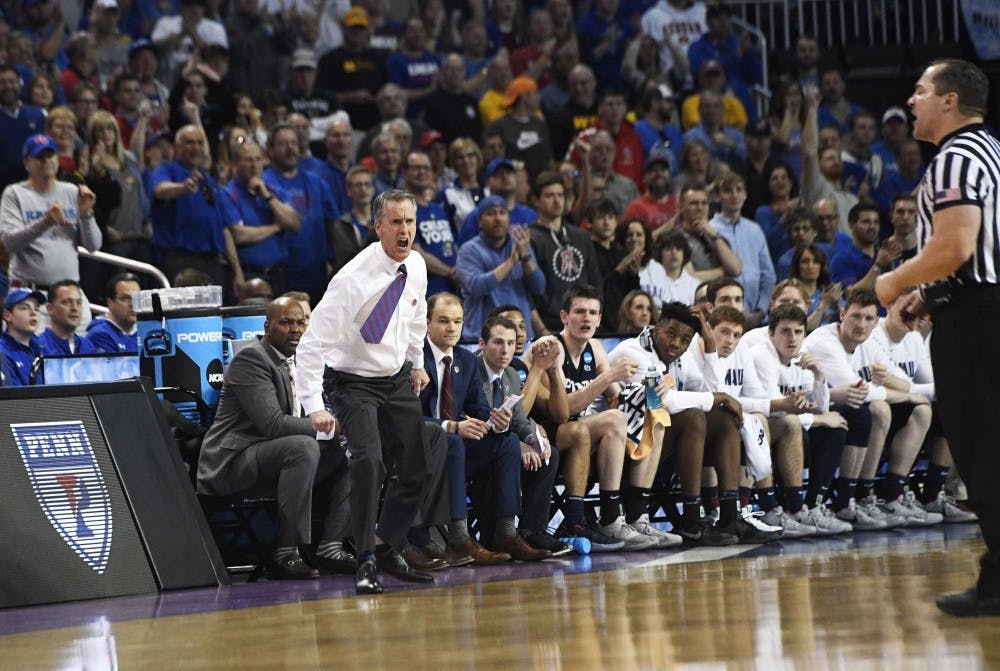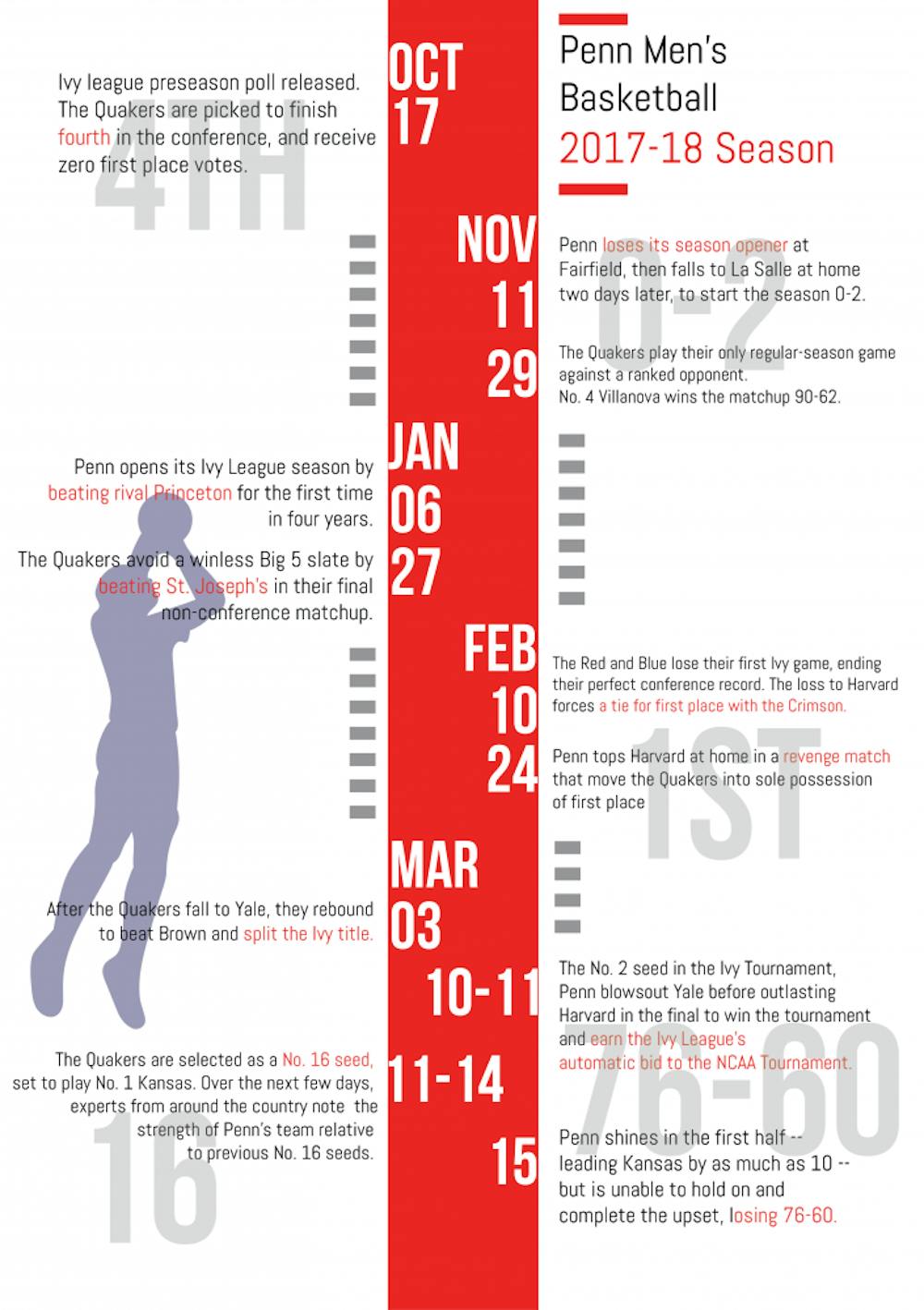
The NCAA Selection Committee failed Penn men's basketball and the nation by giving the Quakers a No. 16 seed.
Credit: Chase SuttonThe Selection Committee got it wrong. There, I said it.
When the NCAA announced the seeding of this year’s men’s basketball tournament, just hours after Penn men’s basketball beat Harvard to claim the Ivy League’s automatic bid, Penn’s celebratory mood was dampened. The Quakers had been selected as a No. 16 seed.
Before I get into the nitty-gritty of how the Committee got it wrong, and why it was such a big mistake, I want to acknowledge the benefits of their decision.
Penn’s status as a No. 16 seed earned them national attention from outlets such as ESPN’s Around the Horn, statistical analytics website FiveThirtyEight, The New York Times, and commentators like Seth Davis.
For about a week — not to mention 15 glorious minutes of game time — Penn men’s basketball was in the hearts and minds of college basketball fans across the country.
Here’s the problem: every single one of those experts and media outlets disagreed with the Committee’s decision to put Penn at No. 16.
While some of that attention on Penn was precisely because of its seeding, Penn would have had an even greater chance for an upset — and an even greater spot in America’s collective sports consciousness — with a higher seed.
The seeding wasn’t the only problem. Penn had to play national powerhouse Kansas in its home state. All NCAA Tournament games are nominally supposed to be played at neutral sites. This one was anything but.
Kansas would have probably still won even if the game was held in the Palestra, but having a full Wichita crowd behind them certainly helped the Jayhawks bounce back from their early struggles.
The draw was the second-worst possible scenario for Penn, with the only exception having been a potential First Four play-in game earlier in the week.

What was upsetting about Penn’s seeding was the disrespect that came with it. Not that this was anything new for the Quakers.
“All year I feel like we’ve been counted out,” sophomore AJ Brodeur said. “Like at the start of the season. Ivy League preseason, we’re fourth in the league; I know we’re better than that. We win the regular season; we’re given a No. 2 seed based on some arbitrary tie-breaker. I know we’re better than that. We win the Ivy League Championship. Selection Sunday, we draw a No. 16 seed. I know we’re better than that.”
Brodeur is right in more ways than one. In some of the objective metrics used by the Committee that measure team strength, Penn was ranked well above the rest of their No. 16 seeds, and even above most of the No. 15s and No. 14s.
In RPI, Penn is 115th in the nation. The other five No. 16 seeds average a ranking of 194th. Two No. 15s, CSU Fullerton and Georgia State were ranked below Penn. In BPI, Penn was ranked 100th, above 14 other NCAA Tournament qualifiers, including all the other No. 16s, and three of the four No. 13 seeds.
Those metrics have been called into question because of lack of accuracy, so let’s look at some more advanced metrics. In Kenpom, Penn was ranked 126th, making it the highest ranked No. 16 seed in six seasons. According to FiveThirtyEight’s Elo ranking system, 11 tournament teams are worse than the Quakers.
Despite these statistical metrics, the Committee placed Penn 64th on the 68-team S-curve ranking, below No. 16 UMBC.

The No. 16 seed is the lowest seed for an Ivy League champion since Princeton’s 1989 team that famously lost to Georgetown by a single point. Penn is not the worst Ivy champion in almost 30 years, and the Ivy League hasn’t gotten that much worse in the past few decades. To that point, earlier this year, ESPN ranked the 32 conferences by collective strength. Based on Penn's seeding, one would expect its conference to rank in the bottom five, but in fact, the Ivy League was one of the stronger mid-majors at 19th.
One of the conferences ranked below the Ivy League was the Big West. This year’s Big West Tournament champion, CSU Fullerton, received a No. 15 seed in the NCAA Tournament, despite finishing fourth in its conference during the regular season. CSU Fullerton didn't have a stronger schedule either; its biggest non-conference win was probably over Harvard.
Based on any metric: the old-school empirical rankings, advanced models, the eye test, and conference strength, Penn was, at worst a No. 15 seed. The Quakers proved they deserved even higher than that with their play against Kansas, who was just as surprised — and likely upset — about Penn’s seeding as I was.
“I think those guys are — they were better than a 16 seed, if you ask me,” Kansas sophomore Mailk Newman said.
His coach agreed:
“I think they're really good," Kansas coach Bill Self said. "You know, I don't study this like some may, but I look at their RPI, and they're 111. I look at their BPI, and they're 100. There's teams in our league [the Big 12] that are about that.”
The only explanation I can offer was endorsed by Penn’s Brodeur earlier this week.
“Especially drawing a 16 seed in the tournament, we take that as a challenge,” he said. “We feel like — that, if you ask us — that we are a lot better than that. But what can you do? Our [conference] tournament is so late, they probably had a lot of the picks already selected before so we just kind of got shoehorned into whatever was open.”
That’s certainly what it felt like. The Committee deprived its audience of a real upset opportunity by shoehorning Penn into what would have been a sensible seed for a worse Harvard team.
It’s a shame that Penn’s great season couldn’t have been rewarded by capping it with a March Madness upset, and a lot of the blame should go to the Committee.

Theodoros Papazekos is a College sophomore from Pittsburgh, Pa., and is a Sports Editor for The Daily Pennsylvanian. He can be reached at papazekos@thedp.com.
The Daily Pennsylvanian is an independent, student-run newspaper. Please consider making a donation to support the coverage that shapes the University. Your generosity ensures a future of strong journalism at Penn.
Donate






